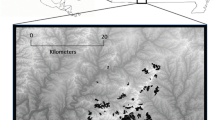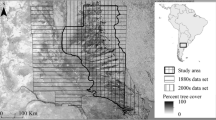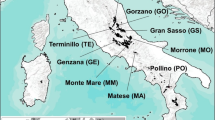Abstract
Context
Woody plant encroachment—the conversion of grasslands to woodlands—is among the greatest challenges faced by rangelands worldwide. Yet this phenomenon is poorly understood, and complex land use dynamics make interpreting the timing and extent of land cover changes a global challenge.
Objectives
For many regions, the true degree and rate of historical change in woody cover and cropland remain unknown. We quantify these processes and explore the effects of prior cultivation on woody plant distribution.
Methods
In the Lampasas Cut Plain, USA, we measured rangeland transformation using digital classification of aerial imagery 1937–2012. Our study is the first to use data of such high spatial and temporal resolution to address this question at this scale. We also provide some of the first documentation of dramatic regional cropland abandonment.
Results
Although total woody cover remained almost unchanged (1937: 28%, 2012: 27 %), woody cover underwent a major redistribution across the landscape. Formerly open areas attained much greater levels of woody cover, and previously wooded areas lost woody cover. As cropland area declined by 78 %, woody plants invaded former croplands more slowly than the rangeland portions of the area (0.1 % year−1 vs. 0.3 % year−1, respectively).
Conclusions
These findings conflict with widely held assumptions and suggest that woody plant encroachment is more nuanced than often recognized. Multiple dynamics and past conditions interact in complex ways to produce landscape change. Because perceptions of encroachment determine how we respond to this challenge, great care should be taken in interpreting observed woody plant encroachment of the world’s rangelands.




Similar content being viewed by others
References
Allison JE (1991) Soil survey of Lampasas County. US Department of Agriculture Soil Conservation Service, Washington, D.C, Texas, p 154
Allred BW (1949) Distribution and control of several woody plants in Texas and Oklahoma. J. Range Manage. 2(1):17–29
Archer S (1994) Woody plant encroachment into southwestern grasslands and savannas: rates, patterns and proximate causes. In: Vavra M, Laycock WA, Pieper RD (eds) Ecological implications of livestock herbivory in the west. Society for Range Management, Denver, pp 13–68
Archer SR, Davies KR, Fulbright TE, McDaniel KC, Wilcox BP, Predick KI, Briske DD (2011) Brush management as a rangeland conservation strategy: a critical evaluation. In: US Department of Agriculture (ed) Conservation benefits of rangeland practices: assessment, recommendations, and knowledge gaps. US Department of Agriculture Natural Resources Conservation Service, Washington, D.C, pp 105–170
Asner G, Archer S, Hughes RF, Ansley RJ, Wessman C (2003) Net changes in regional woody vegetation cover and carbon storage in Texas Drylands, 1937–1999. Glob Change Biol 9:316–335
Asner G, Elmore AJ, Olander LP, Martin RE, Harris AT (2004) Grazing systems, ecosystem responses, and global change. Annu Rev Environ Resour 29(1):261–299
Baer SG, Kitchen DJ, Blair JM, Rice CW (2002) Changes in ecosystem structure and function along a chronosequence of restored grasslands. Ecol Appl 12(6):1688–1701
Battaglia L, Minchin P, Pritchett D (2002) Sixteen years of old-field succession and reestablishment of a bottomland hardwood forest in the Lower Mississippi Alluvial Valley. Wetlands 22(1):1–17
Benjamin K, Domon G, Bouchard A (2005) Vegetation composition and succession of abandoned farmland: effects of ecological, historical and spatial factors. Landscape Ecol. 20(6):627–647
Berg MD, Sorice MG, Wilcox BP, Angerer JP, Rhodes EC, Fox WE (2015) Demographic changes drive woody plant cover trends—an example from the great plains. Rangel. Ecol. Manag. 68(4):315–321
Blaschke T (2010) Object based image analysis for remote sensing. ISPRS J Photogramm Remote Sens 65(1):2–16
Bray WL (1904) Forest resources of Texas. US Department of Agriculture Bureau of Forestry, Washington, D.C.
Breshears DD (2006) The grassland-forest continuum: trends in ecosystem properties for woody plant mosaics? Front Ecol Environ 4(2):96–104
Briggs JM, Hoch GA, Johnson LC (2002) Assessing the rate, mechanisms, and consequences of the conversion of tallgrass prairie to Juniperus virginiana forest. Ecosystems 5(6):578–586
Briggs JM, Knapp AK, Blair JM, Heisler JL, Hoch GA, Lett MS, McCarron JK (2005) An ecosystem in transition: causes and consequences of the conversion of mesic grassland to shrubland. Bioscience 55(3):243–254
Briggs JM, Spielmann KA, Schaafsma H, Kintigh KW, Kruse M, Morehouse K, Schollmeyer K (2006) Why ecology needs archaeologists and archaeology needs ecologists. Front Ecol Environ 4(4):180–188
Briske DD, Fuhlendorf SD, Smeins FE (2003) Vegetation dynamics on rangelands: a critique of the current paradigms. J Appl Ecol 40(4):601–614
Brown DG, Johnson KM, Loveland TR, Theobald DM (2005) Rural land-use trends in the conterminous United States, 1950–2000. Ecol Appl 15(6):1851–1863
Browning DM, Archer SR, Byrne AT (2009) Field validation of 1930s aerial photography: what are we missing? J Arid Environ 73(9):844–853
Browning DM, Laliberte AS, Rango A (2010) Temporal dynamics of shrub proliferation: linking patches to landscapes. Int J Geogr Inf Sci 25(6):913–930
Campbell BD, Stafford Smith DM, Ash AJ, Fuhrer J, Gifford RM, Hiernaux P, Howden SM, Jones MB, Ludwig JA, Manderscheid R, Morgan JA, Newton PCD, Nösberger J, Owensby CE, Soussana JF, Tuba Z, Zuo Zhong C (2000) A synthesis of recent global change research on pasture and rangeland production: reduced uncertainties and their management implications. Agric Ecosyst Environ 82(1–3):39–55
Chavez-Ramirez F, Slack RD (1994) Effects of avian foraging and post-foraging behavior on seed dispersal patterns of Ashe juniper. Oikos 71(1):40–46
Clower DF (1980) Soil survey of Brown and Mills Counties. US Department of Agriculture Soil Conservation Service, Washington, D.C, Texas, p 181
Coppedge BR, Engle DM, Fuhlendorf SD (2007) Markov models of land cover dynamics in a southern Great Plains grassland region. Landscape Ecol. 22(9):1383–1393
Coppedge BR, Engle DM, Fuhlendorf SD, Masters RE, Gregory MS (2001) Landscape cover type and pattern dynamics in fragmented southern Great Plains grasslands, USA. Landscape Ecol. 16(8):677–690
Cramer VA (2007) Old fields as complex systems: new concepts for describing the dynamics of abandoned farmland. In: Cramer VA, Hobbs RJ (eds) Old fields: dynamics and restoration of abandoned farmland. Island Press, Washington, pp 31–46
Dale V, Archer S, Chang M, Ojima D (2005) Ecological impacts and mitigation strategies for rural land management. Ecol Appl 15(6):1879–1892
De Steven D (1991) Experiments on mechanisms of tree establishment in old-field succession: seedling emergence. Ecology 72(3):1066–1075
Denevan WM (1992) The Pristine Myth: the landscape of the Americas in 1492. Ann Assoc Am Geogr 82(3):369–385
Diamond DD, Rowell GA, Keddyhector DP (1995) Conservation of Ashe juniper (Juniperus-ashei Buchholz) woodlands of the central Texas Hill-Country. Nat. Areas J. 15(2):189–197
Drummond MA (2007) Regional dynamics of grassland change in the western Great Plains. Gt Plains Res 17:133–144
Drummond MA, Auch RF, Karstensen KA, Sayler KL, Taylor JL, Loveland TR (2012) Land change variability and human-environment dynamics in the United States Great Plains. Land Use Policy 29(3):710–723
Dyksterhuis EJ (1949) Condition and management of range land based on quantitative ecology. J. Range Manage. 2(3):104–115
Eldridge DJ, Bowker MA, Maestre FT, Roger E, Reynolds JF, Whitford WG (2011) Impacts of shrub encroachment on ecosystem structure and functioning: towards a global synthesis. Ecol Lett 14(7):709–722
Engle DM, Kulbeth JD (1992) Growth dynamics of crowns of eastern redcedar at 3 locations in Oklahoma. J. Range Manage. 45:301–305
Foster JH (1917) The spread of timbered areas in central Texas. J Forest 15(4):442–445
Fowler NL, Simmons MT (2009) Savanna dynamics in central Texas: just succession? Appl Veg Sci 12(1):23–31
Geddes LS, Lunt ID, Smallbone LT, Morgan JW (2011) Old field colonization by native trees and shrubs following land use change: could this be Victoria’s largest example of landscape recovery? Ecol Manag Restor 12(1):31–36
Gibbes C, Adhikari S, Rostant L, Southworth J, Qiu Y (2010) Application of object based classification and high resolution satellite imagery for savanna ecosystem analysis. Remote Sens 2(12):2748–2772
Gill DS, Marks PL (1991) Tree and shrub seedling colonization of old fields in central New York. Ecol Monogr 61(2):183–205
Gimeno TE, Escudero A, Delgado A, Valladares F (2012) Previous land use alters the effect of climate change and facilitation on expanding woodlands of Spanish juniper. Ecosystems 15(4):564–579
Hall MT (1955) Comparison of juniper populations on an Ozark glade and old fields. Ann Mo Bot Gard 42(2):171–194
Harden CP (1996) Interrelationships between land abandonment and land degradation: a case from the Ecuadorian Andes. Mt Res Dev 16(3):274–280
Higgins SI, Bond WJ, Trollope WSW (2000) Fire, resprouting and variability: a recipe for grass–tree coexistence in savanna. J Ecol 88(2):213–229
Hobbs RJ, Cramer VA (2007) Why old fields? socioeconomic and ecological causes and consequences of land abandonment. In: Cramer VA, Hobbs RJ (eds) Old fields: dynamics and restoration of abandoned farmland. Island Press, Washington, pp 1–14
Hoshino A, Tamura K, Fujimaki H, Asano M, Ose K, Higashi T (2009) Effects of crop abandonment and grazing exclusion on available soil water and other soil properties in a semi-arid Mongolian grassland. Soil Tillage Res 105(2):228–235
Hunt JER Jr, Everitt JH, Ritchie JC, Moran MS, Booth DT, Anderson GL, Clark PE, Seyfried MS (2003) Applications and research using remote sensing for rangeland management. Photogramm Eng Remote Sens 69(6):675–693
Jacobs BF (2011) Spatial patterns and ecological drivers of historic piñon–juniper woodland expansion in the American southwest. Ecography 34(6):1085–1095
Jordan-Bychkov TG, Bean JL, Holmes WM (1984) Texas, a geography. Westview Press, Boulder
King DM, Skirvin SM, Collins CDH, Moran MS, Biedenbender SH, Kidwell MR, Weltz MA, Diaz-Gutierrez A (2008) Assessing vegetation change temporally and spatially in southeastern Arizona. Water Resour Res. doi:10.1029/2006WR005850
Knick ST, Rotenberry JT (2000) Ghosts of habitats past: contribution of landscape change to current habitats used by shrubland birds. Ecology 81(1):220–227
Knops JMH, Tilman D (2000) Dynamics of soil nitrogen and carbon accumulation for 61 years after agricultural abandonment. Ecology 81(1):88–98
Laliberte AS, Rango A, Havstad KM, Paris JF, Beck RF, McNeely R, Gonzalez AL (2004) Object-oriented image analysis for mapping shrub encroachment from 1937 to 2003 in southern New Mexico. Remote Sens Environ 93(1–2):198–210
Li YY, Shao MA (2006) Change of soil physical properties under long-term natural vegetation restoration in the Loess Plateau of China. J Arid Environ 64(1):77–96
Loveland TR, Acevedo W (2006) Land cover change in the Eastern United States. Land Cover Trends Project. United States Geological Survey, Center for Earth Observations and Science, Sioux Falls. http://landcovertrends.usgs.gov/east/regionalSummary.html. Accessed 19 Nov 2013
Ludwig JA, Wilcox BP, Breshears DD, Tongway DJ, Imeson AC (2005) Vegetation patches and runoff-erosion as interacting ecohydrological processes in semiarid landscapes. Ecology 86(2):288–297
Miller RF (2005) Biology, ecology, and management of western juniper (Juniperus occidentalis). Technical Bulletin 152. Oregon State University Agricultural Experiment Station, Corvallis, p. 82
Miller RF, Wigand PE (1994) Holocene changes in semiarid pinyon-juniper woodlands. Bioscience 44(7):465–474
Motzkin G, Foster D, Allen A, Harrod J, Boone R (1996) Controlling site to evaluate history: vegetation patterns of a New England sand plain. Ecol Monogr 66(3):345–365
Paine RT, Tegner MJ, Johnson EA (1998) Compounded perturbations yield ecological surprises. Ecosystems 1(6):535–545
Parton WJ, Gutmann MP, Williams SA, Easter M, Ojima D (2005) Ecological impact of historical land-use patterns in the Great Plains: a methodological assessment. Ecol Appl 15(6):1915–1928
Pickett STA, Collins SL, Armesto JJ (1987) Models, mechanisms and pathways of succession. Bot Rev 53(3):335–371
Platt RV, Schoennagel T (2009) An object-oriented approach to assessing changes in tree cover in the Colorado Front Range 1938–1999. For Ecol Manage 258(7):1342–1349
Poznanovic AJ, Falkowski MJ, Maclean AL, Smith AMS, Evans JS (2014) An accuracy assessment of tree detection algorithms in juniper woodlands. Photogramm Eng Remote Sens 80(7):627–637
Prach K, Pyšek P (2001) Using spontaneous succession for restoration of human-disturbed habitats: experience from Central Europe. Ecol Eng 17(1):55–62
Ramankutty N, Foley JA (1999a) Estimating historical changes in global land cover: croplands from 1700 to 1992. Glob Biogeochem Cycle 13(4):997–1027
Ramankutty N, Foley JA (1999b) Estimating historical changes in land cover: North American croplands from 1850 to 1992. Glob Ecol Biogeogr 8(5):381–396
Ramankutty N, Heller E, Rhemtulla J (2010) Prevailing myths about agricultural abandonment and forest regrowth in the United States. Ann Assoc Am Geogr 100(3):502–512
Redcedar Task Force (2002) A strategy for control and utilization of invasive juniper species in Oklahoma. Oklahoma City, Oklahoma
Sankaran M, Hanan NP, Scholes RJ, Ratnam J, Augustine DJ, Cade BS, Gignoux J, Higgins SI, Le Roux X, Ludwig F, Ardo J, Banyikwa F, Bronn A, Bucini G, Caylor KK, Coughenour MB, Diouf A, Ekaya W, Feral CJ, February EC, Frost PGH, Hiernaux P, Hrabar H, Metzger KL, Prins HHT, Ringrose S, Sea W, Tews J, Worden J, Zambatis N (2005) Determinants of woody cover in African savannas. Nature 438(7069):846–849
Schlesinger WH, Reynolds JF, Cunningham GL, Huenneke LF, Jarrell WM, Virginia RA, Whitford WG (1990) Biological feedbacks in global desertification. Science 247(4946):1043–1048
Scholes RJ, Archer SR (1997) Tree-grass interactions in savannas. Annu Rev Ecol Syst 28(1):517–544
Sjöholm H, Reynders MI, Ffolliott P (1989) The arid environments. Arid Zone Forestry: A Guide for Field Technicians. Food and Agriculture Organization of the United Nations, Rome, 150 pp
Smeins FE, Fuhlendorf SD (1997) Biology and ecology of Ashe juniper. In: Taylor Jr CA (ed) Juniper symposium, San Angelo, Texas. Texas Agricultural Extension Service
Smeins FE, Merrill LB (1988) Long-term change in a semi-arid grassland. In: Amos BB, Gehlbach FR (eds) Edwards Plateau vegetation—plant ecological studies in central Texas. Baylor University Press, Waco, pp 101–114
Sorice MG, Kreuter UP, Wilcox BP, Fox WE (2012) Classifying land-ownership motivations in central, Texas, USA: a first step in understanding drivers of large-scale land cover change. J Arid Environ 80:56–64
Swetnam TW, Betancourt JL (1998) Mesoscale disturbance and ecological response to decadal climatic variability in the American Southwest. J Clim 11(12):3128–3147
Texas State Soil and Water Conservation Board (2005) State brush control plan. Texas, Texas State Soil and Water Conservation Board, p 53
Twidwell D, Wonkka CL, Taylor CA, Zou CB, Twidwell JJ, Rogers WE (2013) Drought-induced woody plant mortality in an encroached semi-arid savanna depends on topoedaphic factors and land management. Appl Veg Sci 17(1):42–52
Van Auken OW (2000) Shrub invasions of North American semiarid grasslands. Annu Rev Ecol Syst 31:197–215
Van Auken OW, Jackson JT, Jurena PN (2005) Survival and growth of Juniperus seedlings in Juniperus woodlands. Plant Ecol 175(2):245–257
Wacker MJ, Kelly NM (2004) Ranchers vs. ranchettes in California’s oak rangelands. Rangelands 26(2):17–22
Waisanen PJ, Bliss NB (2002) Changes in population and agricultural land in conterminous United States counties, 1790 to 1997. Glob Biogeochem Cycle 16(4):1137
Weniger D (1984) The explorers’ Texas: the lands and waters. Eakin Publications, Austin
Acknowledgments
We thank J. McAlister for supplying local landscape information and other technical support. This work was supported by USDA-NIFA Managed Ecosystems grant 2011-68002-30015, USDA-NIFA National Needs Program grant 2009-38420-05631, NSF-CNH grant 413900, and a Tom Slick Graduate Research Fellowship from the Texas A&M University College of Agriculture and Life Sciences.
Author information
Authors and Affiliations
Corresponding author
Rights and permissions
About this article
Cite this article
Berg, M.D., Wilcox, B.P., Angerer, J.P. et al. Deciphering rangeland transformation—complex dynamics obscure interpretations of woody plant encroachment. Landscape Ecol 31, 2433–2444 (2016). https://doi.org/10.1007/s10980-016-0412-8
Received:
Accepted:
Published:
Issue Date:
DOI: https://doi.org/10.1007/s10980-016-0412-8




